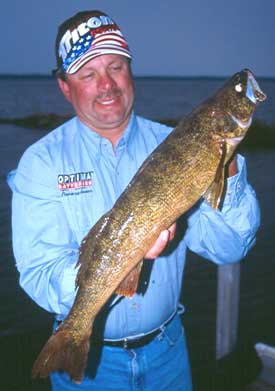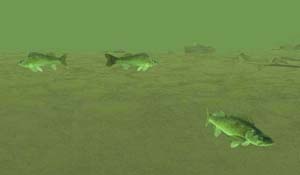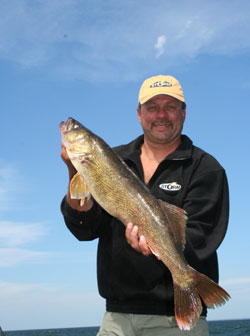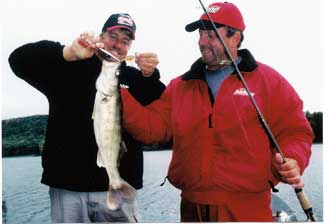 Poker stars Phil Hellmuth, Doyle Brunson and Johnny Chan could have been great tournament anglers. With each new hand, they gather and process the information they know to be fact and develop a strategy. As the hand plays out, they apply instinct and intuition to improve their odds.
Poker stars Phil Hellmuth, Doyle Brunson and Johnny Chan could have been great tournament anglers. With each new hand, they gather and process the information they know to be fact and develop a strategy. As the hand plays out, they apply instinct and intuition to improve their odds.
They know when to hold ’em and when to fold ’em, and when the dealing’s done, they are often the players counting tall stacks of chips while others lament the mistakes that left them with empty wallets.
Late-summer walleye fishing is a gamble, too. It’s all about getting a read on the situation and then putting your expertise and experience into play. One of the games walleyes play this time of year is like an old-fashioned, high-low poker game. Our challenge isn’t so much how to catch them as deciding when to go high and when to go low. There is no question that walleyes are often suspended during the warmest part of the open-water season. In smaller bodies of water, stratification is the primary reason as fish seek layers of water with adequate oxygen. In larger bodies of water, a combination of comfort and the availability of forage are at work.
From the Great Lakes to reservoirs and huge inland lakes like Winnebago, Mille Lacs and Lake of the Woods, it’s not uncommon for the screen on my Humminbird sonar unit to be littered with fish in certain areas. Typically, they’ll be scattered from about 10 feet down all the way to the bottom. Any fish higher in the column are probably moving away as the boat approaches and not showing up without Humminbird’s side-imaging technology.

These fish also tend to be loosely schooled, meaning they are scattered over a sizeable area. That makes trolling the best approach. Each day is different, so it’s sound strategy to start with a set-up that covers a broad range of depths. And don’t read too much into what you see with the naked eye. There are no foolproof indicators that reveal where the suckers are sitting at this metaphorical card table. Bug hatches that attract baitfish and provide food will at times bring walleyes close to the surface. So will slight algae blooms or a nice chop on the surface that break up the penetrating rays of sunlight.
However, I’ve also seen far too many days when it’s been flat, calm, sunny and blistering hot when the most active walleyes were just a couple of feet below the surface. And I’ve seen just as many days when, despite the generally accepted indicators of a high-column bite, the only fish I’ve been able to catch were those in the middle or near the bottom.
 Set up an initial spread that targets the fish you can see on sonar. Keep in mind that walleyes, like most gamefish species, have eyes near the top of their heads. That means they see what’s above them better than they see what’s below them, and our trolling presentations should take that into account. A walleye will raise 10 feet before it will descend a foot to take a bait. And while 30-inch walleyes can be mixed right in with 15-inchers when they are active, they often settle in closer to the bottom when they’ve had their fill. Put the right bait in front of them and they can still be caught.
Set up an initial spread that targets the fish you can see on sonar. Keep in mind that walleyes, like most gamefish species, have eyes near the top of their heads. That means they see what’s above them better than they see what’s below them, and our trolling presentations should take that into account. A walleye will raise 10 feet before it will descend a foot to take a bait. And while 30-inch walleyes can be mixed right in with 15-inchers when they are active, they often settle in closer to the bottom when they’ve had their fill. Put the right bait in front of them and they can still be caught.
I like to work from the bottom up early in the day, targeting first the fish that have settled lower in the column overnight, which often are also those larger fish. If I have another angler in the boat and can fish four lines, two of them will work near the lowest fish I see on sonar, one will probe the middle and I’ll run one just above the highest fish I mark. As the day proceeds, I’ll reverse my approach and put more lines high in the column where the majority of the active fish tend to hang out. Off-Shore planer boards help me spread my lines for maximum water coverage. Keep in mind that weather conditions may dictate some adjustments during the day. Thunder, lightning or just a strong front may push the fish down in the water column where they could remain for a few hours or a few days.
Sometimes, it’s like the fish have simply vanished. Areas where you caught them a day earlier or even a few hours earlier look like the dead sea. Or, you may still mark numbers of fish scattered throughout the column, but you can no longer catch them. That tells me it’s time to get a bait or two right below the surface and go into stealth mode. Get your boards far away from the boat and use your electric trolling motor. It’s a situation where my MinnKota Engine-Mount 101 excels and, with Optima batteries providing the power, I can fish that way all day if need be. Another decision to make is what hand to draw to. Should you play for the crankbait flush or the spinner/crawler straight? Both can be highly productive.

Basically, crankbaits are an effective tool when the fish are scattered and you need to cover water. Once you’ve narrowed down an area, spinner/crawler combos are hard to beat because of the flash, vibration and scent they provide. There will be
times, however, when the fish are just plain finicky and the only way to get on a consistent bite is by buzzing a crankbait past or dangling a slow-moving spinner and crawler in front of indecisive fish. Sometimes, it’s a spinner/crawler bite early in the day and a crankbait bite later, or vice-versa.
You will have to consider wave action into your game plan, as well. If it’s rough, the violent movement and speed of your lures can dramatically decrease your effectiveness. Trolling with the wind and keeping your boards closer to the boat with less line out will help smooth out the presentation, but it may not help you achieve the necessary speed. When I need to slow down, I’ll often turn off my Mercury kicker motor and drift. If that’s not enough, I toss out a drift sock. If that’s still not enough, I’ll run the kicker in reverse and use my bow-mount MinnKota Terrova for directional control.
Sometimes, success is as simple as making one subtle adjustment. I’ve seen a lot of days on rough water where my baits on one side of the boat are catching all the fish and I’ve doubled my catch by moving as many lines as possible to that side where they are tracking better or working at a more enticing speed. Snap weights are another effective tool in rough water. Attached 30 to 40 feet ahead of a spinner or crankbait, they act like a leaf spring and absorb much of the shock from a crashing planer board before it reaches your lure. For the same reason, I avoid using braided or hard lines when targeting suspended fish with planer boards. Yo-Zuri’s Hybrid line has some stretch that helps reduce violent movements, and it gives the angler a better chance to stay hooked up while wearing down a fish that can be 250 feet away from the boat.
It’s no bluff. Suspended fish are fun fish to catch. Figuring out the best odds for success is an inviting challenge. Put your cards on the table and go all-in.










